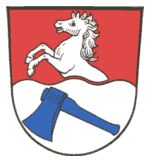Sankt Wolfgang: Difference between revisions
Jump to navigation
Jump to search
Knorrepoes (talk | contribs) m (Text replacement - "/Arms of " to "/Arms (crest) of ") |
Knorrepoes (talk | contribs) m (Text replacement - "{{media}}" to " {{de1}} {{media1}}") |
||
| Line 24: | Line 24: | ||
The horse is taken from the Counts Fraunberger zu Haag, as the area historically belonged to the Haag county. The lower half shows an axe, symbol of St. Wolfgang, the patron saint of the town. The colours of the lower half are those of Bayern. | The horse is taken from the Counts Fraunberger zu Haag, as the area historically belonged to the Haag county. The lower half shows an axe, symbol of St. Wolfgang, the patron saint of the town. The colours of the lower half are those of Bayern. | ||
{{ | |||
{{de1}} | |||
{{media1}} | |||
[[Civic Heraldry Literature - Germany|'''Literature''']]: image from http://www.st-wolfgang-ob.de | [[Civic Heraldry Literature - Germany|'''Literature''']]: image from http://www.st-wolfgang-ob.de | ||
Revision as of 11:21, 26 December 2022
This page is part of the German heraldry portal |
Heraldry of the World |
|
German heraldry:
|
Selected collector's items from Germany:
|
SANKT WOLFGANG
State : Bayern
District (Kreis) : Erding)
Additions : 1971 Gatterberg, Jeßling, Lappach, Pyramoos, Schönbrunn; 1972 Schiltern (partly)
| German |
Wellenförmig geteilt von Rot und Silber; oben ein silberner Pferderumpf, unten ein schräg gestelltes blaues Beil. |
| English | Wolfgang No blazon/translation known. Please click here to send your (heraldic !) blazon or translation |
Origin/meaning
The arms were granted on June 12, 1973.
The horse is taken from the Counts Fraunberger zu Haag, as the area historically belonged to the Haag county. The lower half shows an axe, symbol of St. Wolfgang, the patron saint of the town. The colours of the lower half are those of Bayern.
Literature: image from http://www.st-wolfgang-ob.de


